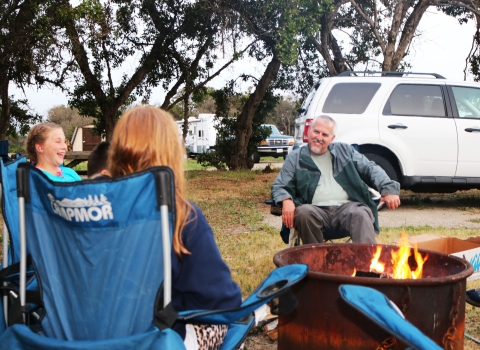Suffolk, Va. — The matchmaking has paid off.
Biologists this week report that red-cockaded woodpeckers trucked from the Carolinas have bred and raised two chicks at Great Dismal Swamp National Wildlife Refuge. The two young mark a milestone in the effort to establish a new population of the endangered bird since it was last seen there more than 40 years ago.
The two chicks hatched in mid-May. Biologists with the Center for Conservation Biology and U.S. Fish and Wildlife Service (Service) quickly captured and banded the duo to keep track of them. Scientists also soon discovered that each was a female. By mid-June, the youngsters had successfully fledged -- they’d learned to fly -- and were foraging with their parents.
Biologists are keeping a close watch on the young fliers, because they represent a unique species of woodpecker. Unlike other woodpeckers, the red-cockaded woodpecker is a social creature and lives in clusters of up to six. Another standout trait: it only breeds in cavities excavated from live pines, using the sap is a defense mechanism against predators.
At one time, the woodpecker’s traditional range stretched across the Southeast, from Virginia south to the Florida Everglades and west to Texas and Oklahoma -- in all, 11 states. Logging, forest management and suppressing fire have reduced that range to a fraction of that original, immense swath of land. The Service estimates that the region is home to about 7,200 potential breeding pairs.
The 112,000-acre Great Dismal Swamp National Wildlife Refuge straddles the border of southeastern Virginia and northeastern North Carolina. It is the last intact remnant of a vast swamp that once spanned more than 1 million acres. Biologists have tried to make part of the refuge habitable for the woodpecker by managing the 2,200-acre Pond Pine Pocosin and establishing 13 cluster sites there. Each has four cavity trees -- 52 cavities in all.
A new home
The woodpecker’s reintroduction to the refuge called upon several recovery partners, including the Virginia Department of Game and Inland Fisheries, The Center for Conservation Biology, the Nature Conservancy, and numerous volunteers.
The reintroduction began in 2015, when the partners began taking woodpeckers from the Carolina Sandhills NWR in South Carolina to the Great Dismal Swamp NWR.
Scientists selected young pairs of birds that had yet to breed, capturing them at night, said Will McDearman, the Service’s red-cockaded woodpecker coordinator. They took them on a nocturnal road trip that wound more than 300 miles before ending at the swamp in Virginia's coastal plain. There, they inserted the pairs in specially prepared tree-cavity nests. They placed mesh over the entrance to each nest to prevent the birds from flying away. And, as the sun rose, biologists removed those temporary barriers. The young birds greeted the new day in a new place.
Biologists so far have relocated nine pairs. They plan to get a few more young pairs of birds this fall, McDearman said.
Road to recovery
The goal is to increase the woodpecker throughout its natural range and eventually delist the species from the federal Endangered Species Act.
The new birds at the swampy refuge will contribute to establishing a second viable breeding population in Virginia. They’ll also support the Service’s goal of having a stable or increasing population of at least 100 potential breeding groups in the Mid-Atlantic Coastal Plain Recovery Unit. That region includes northeastern North Carolina and southeastern Virginia.
Without specific management, the pond pine pocosin habitat is not the ideal spot the woodpecker would have chosen. The typical red-cockaded woodpecker habitat is a park-like pine savanna with a low layer of vegetation underneath, such as grasses and shrubs. During the last several years, the refuge has altered the habitat by removing hardwoods in the overstory, retaining the mature pines and maintaining a shrubby understory. The Service selected it to determine if the species can flourish on the tract in the face of sea-level rise. Scientists also anticipate that saltwater intrusion will render uninhabitable four of five sites where red-cockaded woodpecker is now living.
Scientists, meantime, will watch two young birds spread their wings and soar, figuratively and literally, in their new home.
You can learn more in this blog from our partners at the Center for Conservation Biology.

